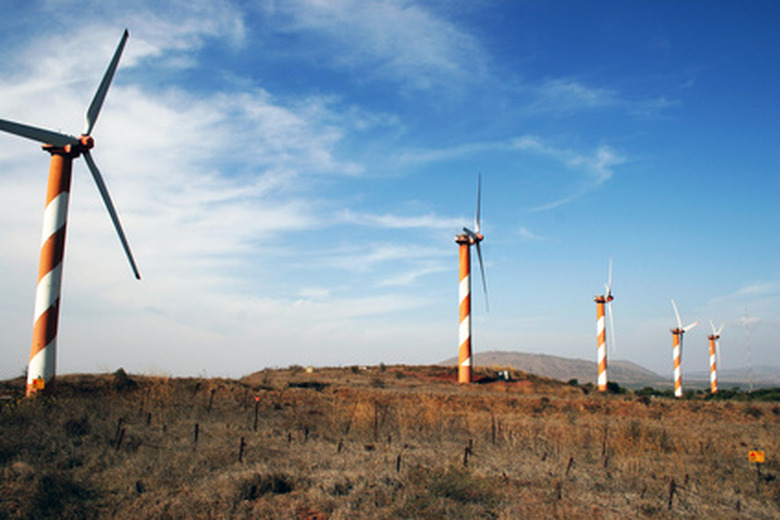How Are Magnets Used To Generate Electricity?
When a conductor is placed in a changing magnetic field, the electrons in the conductor move, generating an electric current. Magnets produce such magnetic fields and can be used in various configurations to generate electricity. Depending on the kind of magnet used, a rotating electric generator can have magnets placed in different locations and can generate electricity in different ways. Most of the electricity in use comes from generators that use magnetic fields to produce that electricity.
TL;DR (Too Long; Didn't Read)
Electric generators rotate coils of wires through magnetic fields created by permanent or electric magnets. As the conducting coils move through the magnetic fields, the electrons in the wires move, creating an electric current.
Using Magnetism to Create Electricity
Using Magnetism to Create Electricity
While an increasing amount of electricity is produced by solar panels and a small amount is obtained from batteries, most electricity comes from generators that use magnetic fields to create electricity. These generators are made up of coils of wire that are either rotated through magnetic fields or are stationary around a shaft with rotating magnets. In either case, the coils of wire are exposed to changing magnetic fields created by the magnets.
The magnets can be permanent or electric magnets. Permanent magnets are mainly used in small generators, and they have the advantage that they don't need a power supply. Electric magnets are iron or steel wound with wire. When electricity passes through the wire, the metal becomes magnetic and creates a magnetic field.
The coils of wire of the generators are conductors, and when the electrons in the wires are exposed to changing magnetic fields, they move, creating an electric current in the wires. The wires are connected together, and the electricity eventually leaves the power station and goes on to power homes and factories.
Trying to Build a Perpetual Magnetic Generator
Trying to Build a Perpetual Magnetic Generator
When permanent magnets are used in a generator, you just have to turn the generator shaft to produce electricity. After these generators were first developed, people thought they could get the generator to power a motor that would then turn the generator. They thought if the motor and generator were matched exactly, they could build a magnetic power source that would run forever as a perpetual motion machine.
Unfortunately, it didn't work. Although such generators and motors are very efficient, they still have electric losses in the resistance of the wires, and there is friction in the shaft bearings. Even when the people doing the experiments got the generator-motor unit to run for a while, eventually it would stop because of the losses and the friction.
How a Typical Power Plant Generator Works
How a Typical Power Plant Generator Works
Large power plants have big, room-sized generators that produce electricity using magnetic fields from electric magnets. Usually the electric magnets are mounted on a shaft and are connected to the electric power supply. When the electricity is switched on, the electric magnets create powerful magnetic fields. Coils of wire are mounted around the shaft. As the shaft with the magnets rotates, the coils of wire are exposed to changing magnetic fields, and an electric current is generated in the wires.
Many different methods can be used to make the shafts of the generators rotate and produce electricity. In wind turbines, the propeller rotates the shaft. In coal and nuclear power plants, the heat from burning the coal or from the nuclear reaction creates steam to run a turbine that drives the generator. In natural gas-powered plants, a gas turbine does the same job. Power plants need a source of energy that can make the generator shaft rotate, and then the magnets can produce the magnetic fields that generate electricity.
Cite This Article
MLA
Markgraf, Bert. "How Are Magnets Used To Generate Electricity?" sciencing.com, https://www.sciencing.com/magnets-used-generate-electricity-6665499/. 29 October 2018.
APA
Markgraf, Bert. (2018, October 29). How Are Magnets Used To Generate Electricity?. sciencing.com. Retrieved from https://www.sciencing.com/magnets-used-generate-electricity-6665499/
Chicago
Markgraf, Bert. How Are Magnets Used To Generate Electricity? last modified March 24, 2022. https://www.sciencing.com/magnets-used-generate-electricity-6665499/
